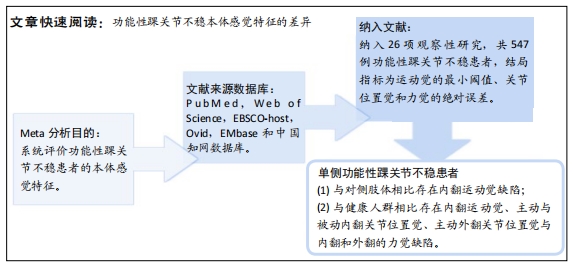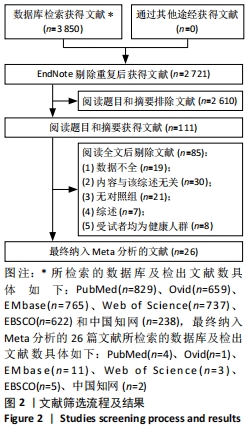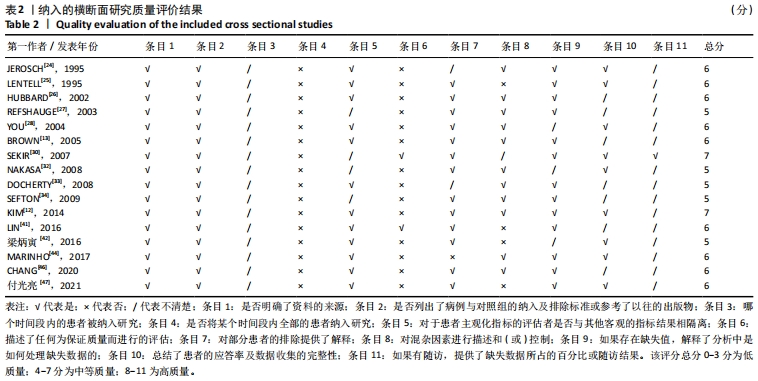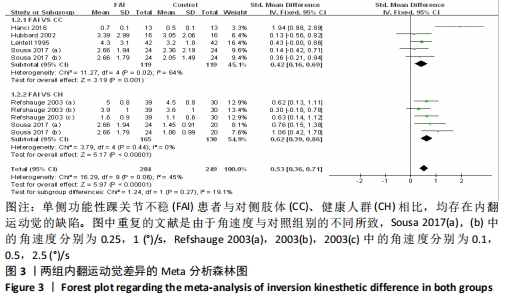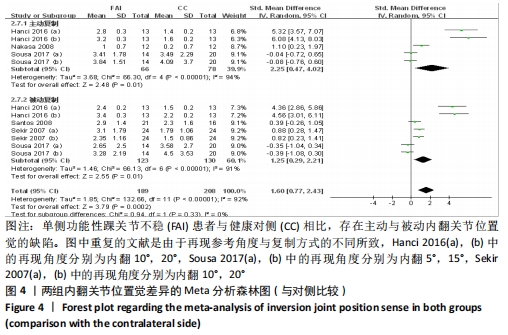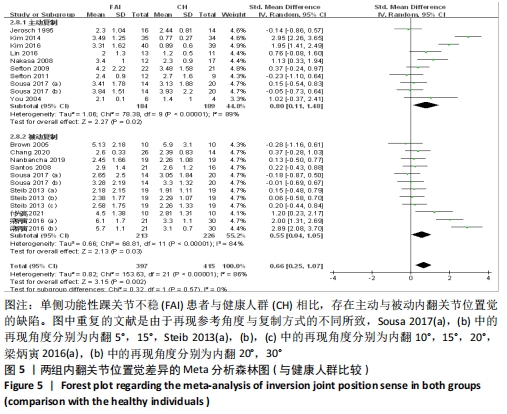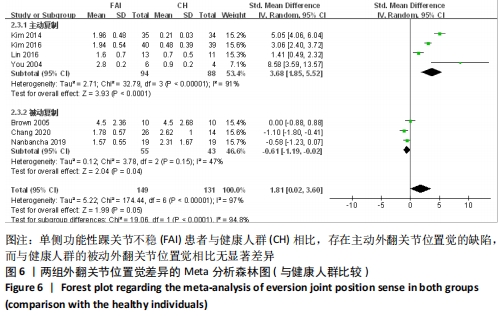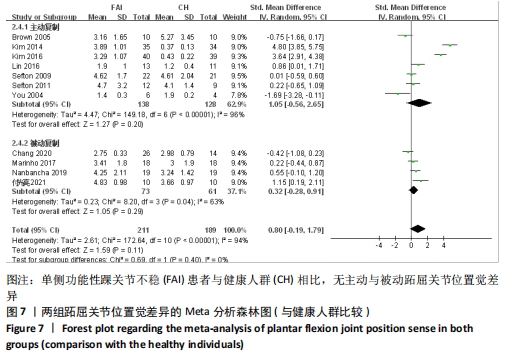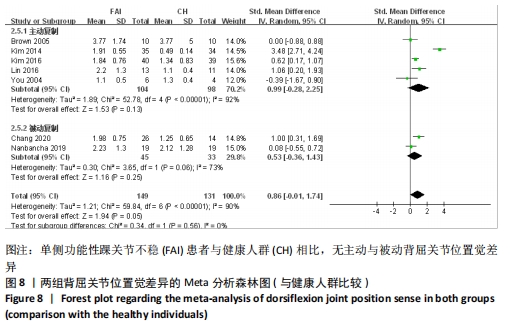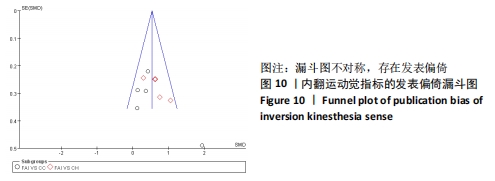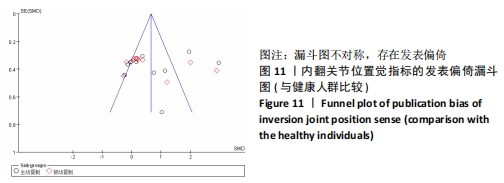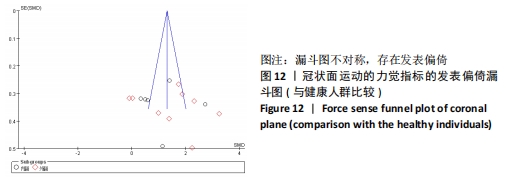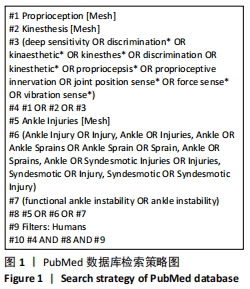[1] MIKLOVIC TM, DONOVAN L, PROTZUK OA, et al. Acute lateral ankle sprain to chronic ankle instability: a pathway of dysfunction. Phys Sports Med. 2018;46(1):116-122.
[2] FREEMAN MA. Instability of the foot after injuries to the lateral ligament of the ankle. J Bone Joint Surg Br. 1965;47(4): 669-677.
[3] FREEMAN MA, DEAN MR, HANHAM IW. The etiology and prevention of functional instability of the foot. J Bone Joint Surg Br. 1965;47(4):678-685.
[4] DOHERTY C, BLEAKLEY C, HERTEL J, et al. Recovery from a first-time lateral ankle sprain and the predictors of chronic ankle instability: a prospective cohort analysis. Am J Sports Med. 2016;44(4):995-1003.
[5] DOHERTY C, DELAHUNT E, CAULFIELD B, et al. The incidence and prevalence of ankle sprain injury: a systematic review and meta-analysis of prospective epidemiological studies. Sports Med. 2014; 44(1):123-140.
[6] HERZOG MM, KERR ZY, MARSHALL SW, et al. Epidemiology of ankle sprains and chronic ankle instability. J Athl Train. 2019; 54(6):603-610.
[7] 张秋霞,张林,王国祥,等.功能性不稳踝关节位置觉和肌肉力觉特征[J].中国运动医学杂志,2012,31(1):9-13
[8] ROSS SE, LINENS SW, WRIGHT CJ, et al. Noise-enhanced eversion force sense in ankles with or without functional instability. J Athl Train. 2015;50(8):819-824.
[9] LIM EC, TAN MH. Side-to-side difference in joint position sense and kinesthesia in unilateral functional ankle instability. Foot Ankle Int. 2009;30(10):1011-1017.
[10] GOBLE DJ. Proprioceptive acuity assessment via joint position matching: from basic science to general practice. Phys Ther. 2010; 90(8):1176-1184.
[11) HAGEN M, LEMKE M, LAHNER M. Deficits in subtalar pronation and supination proprioception in subjects with chronic ankle instability. Hum Mov Sci. 2018;57: 324-331.
[12] KIM CY, CHOI JD, KIM HD. No correlation between joint position sense and force sense for measuring ankle proprioception in subjects with healthy and functional ankle instability. Clin Biomech (Bristol, Avon). 2014;29(9):977-983.
[13] BROWN C, ROSS S, MYNARK R, et al. Assessing functional ankle instability with joint position sense, time to stabilization, and electromyography. J Sport Rehabil. 2004;13(2):122-134.
[14] CHO BK, PARK JK. Correlation between joint-position sense, peroneal strength, postural control, and functional performance ability in patients with chronic lateral ankle instability. Foot Ankle Int. 2019;40(8):961-968.
[15] ALGHADIR AH, IQBAL ZA, IQBAL A, et al. Effect of chronic ankle sprain on pain, range of motion, proprioception, and balance among athletes. Int J Environ Res Public Health. 2020;17(15):5318.
[16] OTZEL DM, HASS CJ, WIKSTROM EA, et al. Motoneuron function does not change following whole-body vibration in individuals with chronic ankle instability. J Sport Rehabil. 2019;28(6):614-622.
[17] WITCHALLS J, WADDINGTON G, BLANCH P, et al. Ankle instability effects on joint position sense when stepping across the active movement extent discrimination apparatus. J Athl Train. 2012;47(6):627-634.
[18] HILLER CE, NIGHTINGALE EJ, LIN CW, et al. Characteristics of people with recurrent ankle sprains: a systematic review with meta-analysis. Br J Sports Med. 2011;45(8): 660-672.
[19] XUE X, CHEN Z, XUAN W, et al. Force sense deficits in chronic ankle instability: a systematic review and meta-analysis. PM R. 2022. doi: 10.1002/pmrj.12833.
[20] GRIBBLE PA, DELAHUNT E, BLEAKLEY CM, et al. Selection criteria for patients with chronic ankle instability in controlled research: a position statement of the International Ankle Consortium. J Athl Train. 2014;49(1):121-127.
[21] Wells G. The Newcastle-Ottawa Scale (NOS) for Assessing the Quality of Non-Randomised Studies in Meta-Analyses// Symposium on Systematic Reviews: Beyond the Basics. 2014.
[22] ROSTOM A, DUBÉ C, CRANNEY A, et al. Celiac disease. Evid Rep Technol Assess (Summ). 2004;(104):1-6.
[23] HIGGINS JP, THOMPSON SG. Quantifying heterogeneity in a meta-analysis. Stat Med. 2002;21(11):1539-1558.
[24] JEROSCH J, HOFFSTETTER I, BORK H, et al. The influence of orthoses on the proprioception of the ankle joint. Knee Surg Sports Traumatol Arthrosc. 1995; 3(1):39-46.
[25] LENTELL G, BAAS B, LOPEZ D, et al. The contributions of proprioceptive deficits, muscle function, and anatomic laxity to functional instability of the ankle. J Orthop Sports Phys Ther. 1995;21(4):206-215.
[26] HUBBARD TJ, KAMINSKI TW. Kinesthesia is not affected by functional ankle instability status. J Athl Train. 2002;37(4):481-486.
[27] REFSHAUGE KM, KILBREATH SL, RAYMOND J. Deficits in detection of inversion and eversion movements among subjects with recurrent ankle sprains. J Orthop Sports Phys Ther. 2003;33(4):166-176.
[28] YOU SH, GRANATA KP, BUNKER LK. Effects of circumferential ankle pressure on ankle proprioception, stiffness, and postural stability: a preliminary investigation. J Orthop Sports Phys Ther. 2004;34(8):449-460.
[29] ARNOLD BL, DOCHERTY CL. Low-load eversion force sense, self-reported ankle instability, and frequency of giving way. J Athl Train. 2006;41(3):233-238.
[30] SEKIR U, YILDIZ Y, HAZNECI B, et al. Effect of isokinetic training on strength, functionality and proprioception in athletes with functional ankle instability. Knee Surg Sports Traumatol Arthrosc. 2007;15(5):654-664.
[31] SANTOS MJ, LIU W. Possible factors related to functional ankle instability. J Orthop Sports Phys Ther. 2008;38(3):150-157.
[32] NAKASA T, FUKUHARA K, ADACHI N, et al. The deficit of joint position sense in the chronic unstable ankle as measured by inversion angle replication error. Arch Orthop Trauma Surg. 2008;128(5):445-449.
[33] DOCHERTY CL, ARNOLD BL. Force sense deficits in functionally unstable ankles. J Orthop Res. 2008;26(11):1489-1493.
[34] SEFTON JM, HICKS-LITTLE CA, HUBBARD TJ, et al. Sensorimotor function as a predictor of chronic ankle instability. Clin Biomech (Bristol, Avon). 2009;24(5):451-458.
[35] SEFTON JM, YARAR C, HICKS-LITTLE CA, et al. Six weeks of balance training improves sensorimotor function in individuals with chronic ankle instability. J Orthop Sports Phys Ther. 2011;41(2):81-89.
[36] WRIGHT CJ, ARNOLD BL. Fatigue’s effect on eversion force sense in individuals with and without functional ankle instability. J Sport Rehabil. 2012;21(2):127-136.
[37] STEIB S, HENTSCHKE C, WELSCH G, et al. Effects of fatiguing treadmill running on sensorimotor control in athletes with and without functional ankle instability. Clin Biomech (Bristol, Avon). 2013;28(7):790-795.
[38] SIMON J, GARCIA W, DOCHERTY CL. The effect of kinesio tape on force sense in people with functional ankle instability. Clin J Sport Med. 2014;24(4):289-294.
[39] HANCI E, SEKIR U, GUR H, et al. Eccentric training improves ankle evertor and dorsiflexor strength and proprioception in functionally unstable ankles. Am J Phys Med Rehabil. 2016;95(6):448-458.
[40] KIM CY, CHOI JD. Comparison between ankle proprioception measurements and postural sway test for evaluating ankle instability in subjects with functional ankle instability. J Back Musculoskelet Rehabil. 2016;29(1): 97-107.
[41] LIN CH, CHIANG SL, LU LH, et al. Validity of an ankle joint motion and position sense measurement system and its application in healthy subjects and patients with ankle sprain. Comput Methods Programs Biomed. 2016;131:89-96.
[42] 梁炳寅,李坤,王予彬,等.本体感觉功能与慢性踝关节不稳相关性的初步研究[J].中华物理医学与康复杂志,2016, 38(11):850-852.
[43] SOUSA ASP, LEITE J, COSTA B, et al. Bilateral proprioceptive evaluation in individuals with unilateral chronic ankle instability. J Athl Train. 2017;52(4):360-367.
[44] MARINHO HVR, AMARAL GM, DE SOUZA MOREIRA B, et al. Influence of passive joint stiffness on proprioceptive acuity in individuals with functional instability of the ankle. J Orthop Sports Phys Ther. 2017; 47(12):899-905.
[45] NANBANCHA A, TRETRILUXANA J, LIMROONGREUNGRAT W, et al. Decreased supraspinal control and neuromuscular function controlling the ankle joint in athletes with chronic ankle instability. Eur J Appl Physiol. 2019;119(9):2041-2052.
[46] CHANG YS, AREFIN MS, YOU YL, et al. Effect of novel remodeled bicycle pedal training on balance performance in athletes with functional ankle instability. Front Bioeng Biotechnol. 2020;8:600187.
[47] 付光亮,孟庆华,鲍春雨.功能性踝关节不稳者本体感觉力学差异及平衡训练干预效果[J].应用力学学报,2021,38(6): 2426-2431.
[48] GRIBBLE PA, BLEAKLEY CM, CAULFIELD BM, et al. Evidence review for the 2016 International Ankle Consortium consensus statement on the prevalence, impact and long-term consequences of lateral ankle sprains. Br J Sports Med. 2016;50(24):1496-1505.
[49] DELAHUNT E, REMUS A. Risk factors for lateral ankle sprains and chronic ankle instability. J Athl Train. 2019;54(6):611-616.
[50] ALGHADIR AH, IQBAL ZA, IQBAL A, et al. Effect of chronic ankle sprain on pain, range of motion, proprioception, and balance among athletes. Int J Environ Res Public Health. 2020;17(15):5318.
[51] EVANS T, HERTEL J, SEBASTIANELLI W. Bilateral deficits in postural control following lateral ankle sprain. Foot Ankle Int. 2004;25(11):833-839.
[52] HERTEL J, BUCKLEY WE, DENEGAR CR. Serial testing of postural control after acute lateral ankle sprain. J Athl Train. 2001;36(4):363-368.
[53] PROSKE U, CHEN B. Two senses of human limb position: methods of measurement and roles in proprioception. Exp Brain Res. 2021;239(11):3157-3174.
[54] PROSKE U, GANDEVIA SC. The proprioceptive senses: their roles in signaling body shape, body position and movement, and muscle force. Physiol Rev. 2012;92(4):1651-1697.
[55] NIESPODZIŃSKI B, KOCHANOWICZ A, MIESZKOWSKI J, et al. Relationship between joint position sense, force sense, and muscle strength and the impact of gymnastic training on proprioception. Biomed Res Int. 2018;2018:5353242.
[56] LAKIE M, CAMPBELL KS. Muscle thixotropy-where are we now? J Appl Physiol (1985). 2019;126(6):1790-1799.
[57] ABDULKARIM Z, EHRSSON HH. Recalibration of hand position sense during unconscious active and passive movement. Exp Brain Res. 2018;236(2):551-561.
[58] KRÖGER S. Proprioception 2.0: novel functions for muscle spindles. Curr Opin Neurol. 2018;31(5):592-598.
[59] ASHTON-MILLER JA, WOJTYS EM, HUSTON LJ, et al. Can proprioception really be improved by exercises? Knee Surg Sports Traumatol Arthrosc. 2001;9(3):128-136.
[60] PROSKE U, GANDEVIA SC. Kinesthetic Senses. Compr Physiol. 2018;8(3):1157-1183.
[61] 张帆,蒋琴华,林榕,等.视觉认知任务介入时踝关节稳定程度对纵跳落地模式影响的研究[J].成都体育学院学报,2020, 46(1):78-85.
[62] HAN J, WADDINGTON G, ADAMS R, et al. Assessing proprioception: a critical review of methods. J Sport Health Sci. 2016;5(1): 80-90.
|
